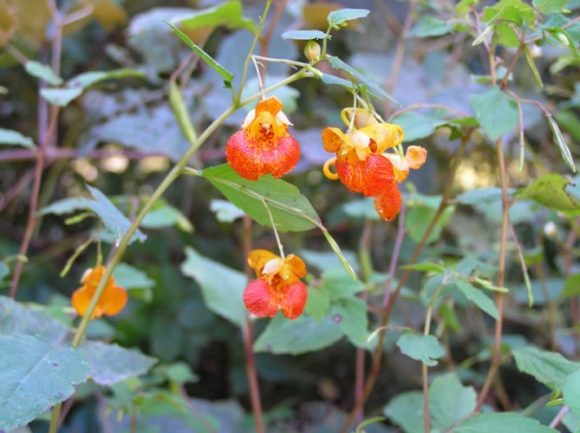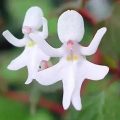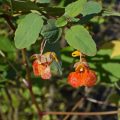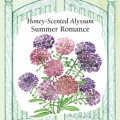- Geraniums: Two Floral Families with Striking Flowers - December 15, 2019
- Festive Flowers for a Dazzling Winter Bouquet or Centerpiece - December 14, 2019
- Forcing Flower Bulbs For the Holiday Season - December 13, 2019
Jewelweed is a yellow or orange flowering plant whose claim to fame is that the ripe seed pods “explode” or burst open when touched. Much to the delight of children and fun-loving adults, these plants have a quite entertaining method of dispersing their seeds.
Also known as touch-me-not, jewelweed grows in damp, marshy areas all across the eastern United States. While these trumpet-shaped flowers are classified as annuals (completing their life cycle within one year), they are so adept at self-sowing their seeds that they return reliably, year after year.
Jewelweed is a member of the impatiens family, which includes the shade-loving blooms of the same name. While common impatiens are readily found at every garden center and nursery, their wild cousins are not commercially cultivated. Like jewelweed, common impatiens also have a seed pod that bursts when fully ripened.
There are two theories about how jewelweed got its name. Some say that the gem-colored flowers glisten and shimmer when wet from rain or dew. Others say that the flowers hang from their stalks like jewels on a necklace. Whatever the case, these brilliant blossoms should not be overlooked.
Jewelweed has evolved to appeal to its primary pollinators, butterflies and hummingbirds. The warm red-orange to yellow hues of the flowers are attractive to these species. The jewelweed releases its seed pods with the gentlest nudge, such as the feather-light touch of a hovering hummingbird.
This fascinating manner of seed dispersal is called “ballistichory”, referring to the way in which the seeds act as projectiles. This enthusiastic popping is achieved by a buildup of tension within the cells as the seed pod dries out. The cell walls gradually begin to coil and the tension is released when the fully ripe pod is touched.
Aside from being fun for inquisitive people, jewelweed has some beneficial qualities as well. The liquid from the stem of the plant is said to be excellent at reducing inflammation when applied topically. It has long been used as a treatment for poison ivy, poison oak, and stinging nettles. In fact, jewelweed is frequently found growing in the vicinity of poison ivy. If you know you have touched the noxious poison ivy, immediately applying liquid from the jewelweed is supposed to reduce the severity of the reaction before it even gets started.
Note: The Right Flowers is not a medical site. Knowledge of and information about the therapeutic benefits and applications of flowers, while known through the ages, does not constitute medical advice. If you are having health issues, you should consult with a physician.
In addition to the medicinal liquid, the seeds of the jewelweed are edible. The seeds can be flung as far as ten feet away when the pod pops open. But if you manage to collect a few, they can safely be eaten. After wiping off the coating on the fresh, ripe seeds, you will find that they taste nutty. This flavor has been compared to walnuts or almonds.
Exploding plants like jewelweed are proof that botany can be fun. There are wondrous things all around us, if you take the time to look. Go for a walk and see what jewels Mother Nature has to offer in your neighborhood.





